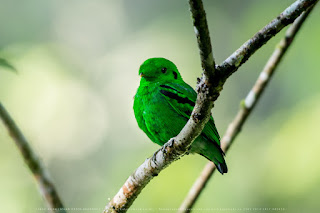 The green broadbill (Calyptomena viridis) also known as the lesser green broadbill is a small bird in the broadbill family. The bird is about 17 cm long, plumaged in brilliant green with a black ear patch, widely gaped bill, rounded head, short tail and three black bars on each wing. The beak itself is very weak and almost hidden by the crest above it. Both sexes are similar. The female is duller and has no black markings on its ear patch and wing coverts.
The green broadbill (Calyptomena viridis) also known as the lesser green broadbill is a small bird in the broadbill family. The bird is about 17 cm long, plumaged in brilliant green with a black ear patch, widely gaped bill, rounded head, short tail and three black bars on each wing. The beak itself is very weak and almost hidden by the crest above it. Both sexes are similar. The female is duller and has no black markings on its ear patch and wing coverts.The green broadbill is distributed in broadleaved evergreen forests of Borneo, Sumatra and the Malay Peninsula where it frequents lowland and lower montane rain forest. It is often overlooked, as it sits motionless inside the canopy or just below, quickly flying to a new location if disturbed. Its foliage-green color provides excellent camouflage.
It feeds largely on soft figs. The broadbill's feeding habits helps to distribute the seeds of the fig around the forest floor. The female usually lays between two and three whitish eggs, and the young fledge after twenty-two to twenty-three days.








No comments:
Post a Comment